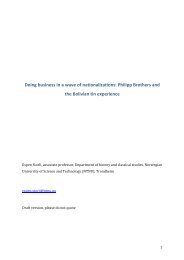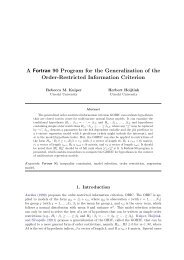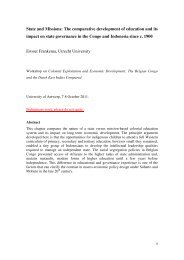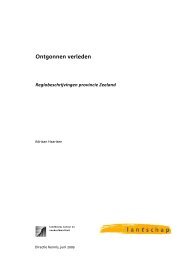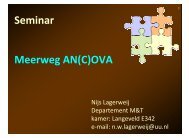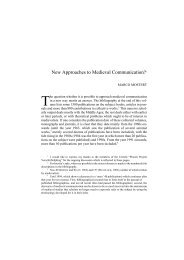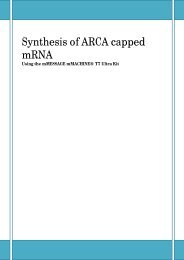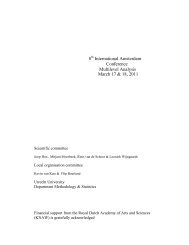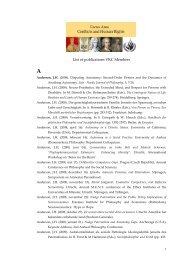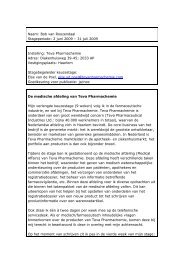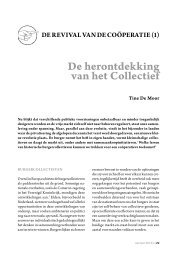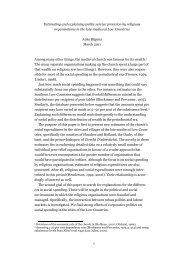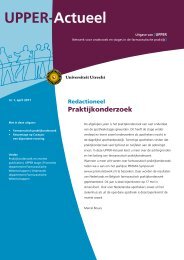Family Structure and Business Organization: Sephardic ... - Partner
Family Structure and Business Organization: Sephardic ... - Partner
Family Structure and Business Organization: Sephardic ... - Partner
Create successful ePaper yourself
Turn your PDF publications into a flip-book with our unique Google optimized e-Paper software.
Draft – Not for circulation without permission<br />
Madras on account of David Sceriman, likely the richest Armenian in Livorno, in the 1740s. 99<br />
The Amsterdam notary archives contain numerous deeds that show how Armenians sold Persian<br />
silk to Dutch merchants <strong>and</strong> bought local textiles from them; some even used bottomary loans (a<br />
mixture of bills of exchange <strong>and</strong> insurance policies) to transfer goods <strong>and</strong> credit between<br />
Moscow <strong>and</strong> the Netherl<strong>and</strong>s. 100 It nonetheless remains unclear how common commission<br />
agency between Armenians <strong>and</strong> non-Armenians was <strong>and</strong> how the parties involved protected<br />
themselves from the risk of opportunism in these varied circumstances.<br />
Overall, both Western Sephardim <strong>and</strong> Armenians relied amply on family <strong>and</strong><br />
communitarian organizations in their commercial endeavors, but they also adopted different<br />
contractual forms (with a preference for commende among Armenians <strong>and</strong> for a combination of<br />
unlimited, bilateral joint partnerships <strong>and</strong> commission agency among Sephardim). They also<br />
developed distinctive governance institutions. Sephardim were prevented from acquiring a<br />
centralized overseeing institution analogous to the Assembly of Merchants in Isfahan. They lived<br />
in different sovereign territories <strong>and</strong> each community negotiated the forms <strong>and</strong> reach of their<br />
jurisdictional autonomy with local political authorities, whether in Livorno, Venice, Hamburg,<br />
Amsterdam, London or elsewhere. The parnassim of each congregation had mainly indirect rule<br />
over economic matters, <strong>and</strong> their ability to settle commercial disputes among Jews varied from<br />
place to place. At same time, intense communication between community leaders <strong>and</strong> individual<br />
merchants as well as the habit of contracting marriage alliances with families overseas ensured<br />
that distinctive networks of cooperation developed within the <strong>Sephardic</strong> diaspora <strong>and</strong> enacted<br />
multilateral channels of reputation control. Finally, the comparison between Armenians <strong>and</strong><br />
Sephardim is intriguing for it shows that Sephardim were more engaged in cross-cultural trade as<br />
defined in this book than Armenians. The less formalized <strong>and</strong> less centralized <strong>Sephardic</strong><br />
organization relied more on non-kin <strong>and</strong> strangers as commission agents than Armenians did.<br />
That Julfan Armenians were more insular than Sephardim in their business dealings is<br />
also at odds with the fact that as Christians, they enjoyed several advantages in Europe precluded<br />
to Sephardim. Julfan men, for example, normally married Julfan women whom they left behind<br />
while they spent their youth on the road, but marriages between Armenians in the diaspora (both<br />
men <strong>and</strong> women) <strong>and</strong> non-Armenian Christians are recorded in Europe, the Ottoman Empire <strong>and</strong><br />
India. 101 Intermarriage accounts for the absorption of Armenians in local societies but also likely<br />
widened their circles of business associates. In order to underst<strong>and</strong> the relationship between<br />
family <strong>and</strong> business organization in the case of Western Sephardim <strong>and</strong> Iranian Armenians, in<br />
sum, we need to consider not only the types of legal contracts that they used, but also the<br />
geographical location, demographic consistency, religious identity <strong>and</strong> marriage customs of the<br />
two diasporas. While the global reach of Iranian Armenians is impressive if we consider that<br />
99 I owe this information to Bhaswati Bhattacharya, who shared with me her notes from the diary of the<br />
English factory in Surat at the State Archives of Maharashtra, India.<br />
100 BEKIUS 2003: 26-34.<br />
101 Already in 1629 a prosperous merchant from Isfahan married a woman from Livorno following the<br />
prescription of the Council of Trent; FRATTARELLI FISCHER 1998: 29. On the marriage alliances between the<br />
business elite of Livorno <strong>and</strong> Armenians, see also FRATTARELLI FISCHER 2006: 29. The Sceriman, the richest<br />
Catholic Armenian family of the diaspora, married into Venetian patrician families; WHITE 1961. For Armenian<br />
women who married officers of the Dutch East India Company in Surat in the late seventeenth century, see<br />
BHATTACHARYA 2005: 306. In Smyrna, Persian Armenians married among themselves, while only a few built<br />
kinship ties to resident French merchants; KÉVONIAN 1975: 210 <strong>and</strong> SMYRNELIS 1995: 38-9.<br />
24



